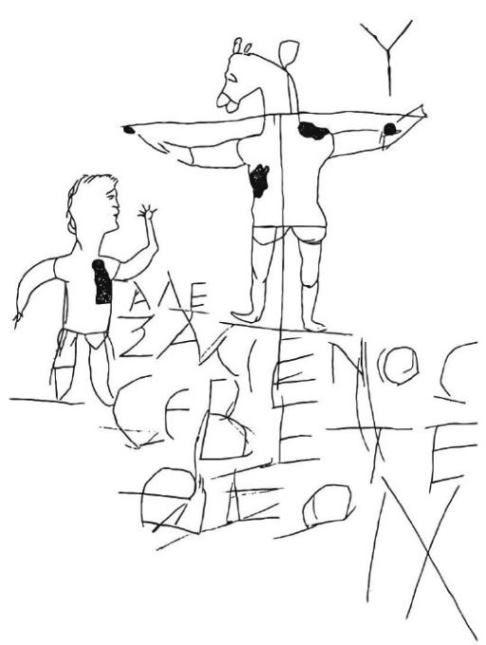The Alexamenos graffitoWhen a building in Rome called the domus Gelotiana was unearthed on the Palatine Hill in 1857, this graffito was discovered carved in plaster on a wall. The emperor Caligula (12-41 AD) had acquired the house for the imperial palace. After Caligula died, the house was used as a Paedagogium or boarding-school for the imperial page boys. Later the street on which the house was located was walled off to give support to extensions to the buildings above, and so it remained sealed for centuries. The image depicts a human-like figure who is attached to a cross and who has the head of a donkey. To the left of the image is a young man, apparently intended to represent Alexamenos, who is raising one hand in a gesture possibly suggesting worship. Beneath the cross there is a caption written in Greek: Αλεξαμενος ϲεβετε θεον, which means "Alexamenos worships (or: worshipping) God".[3] No clear consensus has been reached as to the date in which the image was originally made. Dates ranging from the late 1st to the late 3rd century have been suggested, although the beginning of the 3rd century is thought the most likely date.  Tracing of the Alexamenos graffito carved in the plaster. Tracing of the Alexamenos graffito carved in the plaster.InterpretationThe inscription is accepted by authoritative sources … to be a mocking depiction of a Christian in the act of worship. Both the portrayal of Jesus as having a donkey's head and the depiction of him being crucified would have been considered insulting by contemporary Roman society. Crucifixion continued to be used as an execution method for the worst criminals until its abolition by the emperor Constantine in the 4th century. One interpretation is that the figure in the image has an ass's head to ridicule Christian beliefs. |
Thus this cartoon is possibly the earliest drawing of the crucifixion of Christ, probably completed at the beginning of the 3rd century, ie. in the early two hundreds. It shows Christ on a cross, not a pole or a 'torture stake', with his arms out-stretched to the left and the right. The fact that it was not drawn by a Christian adds to its significance as an independent indication of the nature of crucifixion and that this was the way that Christ died.